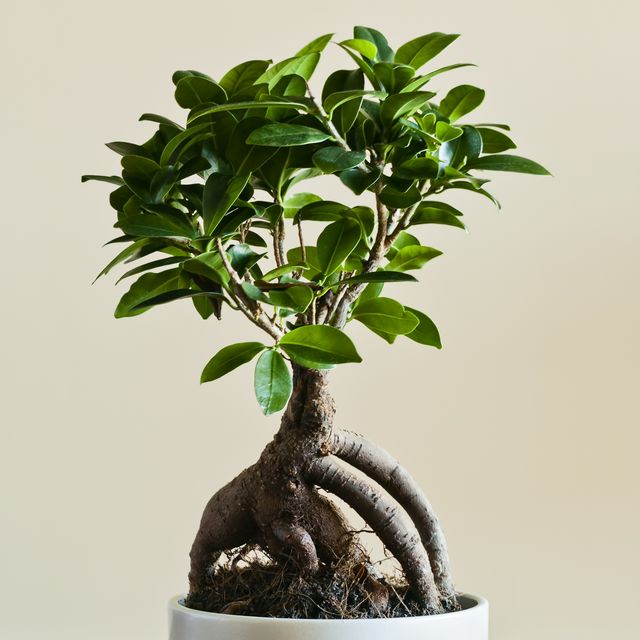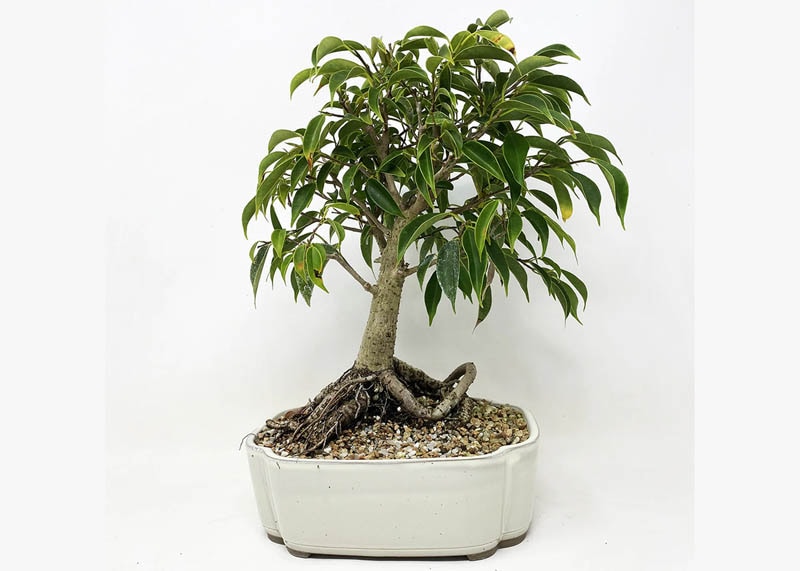Common Fig Bonsai trees need bright indirect sunlight and well-draining soil to thrive. Water the bonsai when the topsoil feels dry.
Caring for a Common Fig Bonsai tree involves understanding its specific needs to ensure healthy growth. These trees require bright, indirect sunlight to photosynthesize effectively. Well-draining soil is crucial to prevent root rot and promote proper nutrient absorption. Regular watering is essential, but the soil should dry out slightly between waterings to avoid overwatering.
Pruning helps maintain the desired shape and encourages new growth. Fertilize the bonsai during the growing season with a balanced fertilizer for optimal health. Monitoring for pests and diseases is also important to keep the tree thriving. With proper care, your Common Fig Bonsai can be a beautiful and rewarding addition to your home or garden.

Credit: www.housebeautiful.com
Introduction To Fig Bonsai
Fig Bonsai trees are popular for their hardiness and unique look. They are perfect for beginners. These trees have thick trunks and aerial roots. This gives them an ancient, magical appearance. Fig Bonsai can grow indoors and outdoors. They adapt well to different environments.
Fig Bonsai trees have distinctive leaves. These leaves are large and shiny. The trees can produce tiny fruits. These fruits add to their charm. Fig Bonsai trees are easy to shape and prune. This makes them a favorite among Bonsai enthusiasts. Their resilient nature allows them to thrive in various conditions.
| Variety | Features |
|---|---|
| Ficus Retusa | Has small, dark green leaves and a thick trunk. |
| Ficus Benjamina | Known for its elegant, weeping branches and glossy leaves. |
| Ficus Microcarpa | Features dense foliage and a compact structure. |
Choosing The Right Fig Bonsai
Caring for a Common Fig Bonsai Tree involves regular pruning and proper watering. Ensure it receives ample sunlight and well-draining soil. Regular monitoring helps prevent pests and diseases, promoting healthy growth.
Selecting Healthy Plants
Pick a plant with shiny leaves. Check for strong roots and no signs of pests. Plants should be disease-free and have a healthy green color. Avoid plants with brown spots or wilted leaves. A healthy plant will grow better.
Ideal Size And Shape
Choose a bonsai that fits your space. Small bonsai are easier to manage. Look for a balanced shape with a nice trunk. The trunk should be thick at the base. This gives the tree a natural look. Prune to maintain the desired shape.
Optimal Growing Conditions
Thriving best in well-drained soil, the Common Fig Bonsai tree flourishes with ample sunlight and regular watering. Ensuring humidity and moderate temperatures supports its optimal growth.
Light Requirements
The Common Fig Bonsai tree needs bright light. Place it near a sunny window. It should get at least 6 hours of sunlight each day. Direct sunlight is best for its growth. If indoors, use grow lights to supplement.
Temperature And Humidity
The ideal temperature range is between 60°F and 75°F. Avoid temperatures below 55°F as it can harm the tree. High humidity is beneficial for the Common Fig Bonsai. Mist the leaves daily to keep them moist. Using a humidity tray can also help maintain the right levels.

Credit: m.youtube.com
Watering Techniques
Water your fig bonsai tree regularly. Make sure the soil is always moist. Dry soil can harm the tree. Water more during hot weather. In cooler months, water less often. Always check the soil before watering. If the topsoil is dry, it’s time to water.
Use room temperature water for your bonsai. Cold water can shock the roots. Water the tree until water drains out the bottom. This ensures the soil is fully wet. Avoid using hard water. It can leave harmful deposits in the soil. Rainwater is the best option. Ensure your bonsai pot has drainage holes. This prevents root rot.
Soil And Fertilization
Proper soil and fertilization ensure the health of a Common Fig Bonsai tree. Use well-draining soil and balanced fertilizer for optimal growth.
Soil Mixtures
Common Fig Bonsai trees thrive in well-drained soil. A good soil mix includes akadama, pumice, and lava rock. These materials ensure proper aeration and moisture retention. Avoid using heavy or compacted soils. They can lead to root rot.
Nutrient Needs
Proper fertilization is crucial for healthy growth. Use a balanced fertilizer with equal parts of nitrogen, phosphorus, and potassium. Apply fertilizer during the growing season. Reduce fertilization during winter. Over-fertilization can harm the tree.
Pruning And Shaping
Pruning and shaping are essential for maintaining the Common Fig Bonsai Tree’s health and aesthetics. Regular trimming encourages dense foliage and a pleasing structure.
When To Prune
Prune your Common Fig Bonsai tree in late winter. This is when the tree is dormant. Pruning in winter helps the tree to heal quickly. Avoid pruning during the growing season. This can stress the tree.
Tools For Pruning
- Pruning shears for small branches
- Concave cutters for thicker branches
- Wire cutters to remove wiring
- Scissors for fine trimming
- Protective gloves to keep hands safe
Pest And Disease Management
The Common Fig Bonsai often attracts spider mites, mealybugs, and scale insects. These pests can harm the tree by sucking its sap. Leaves may turn yellow and drop off. Regularly inspect the tree for these pests. Early detection helps in controlling the damage. Use a magnifying glass for better inspection.
Keep the bonsai in a clean environment. Remove fallen leaves and debris around the tree. This reduces hiding spots for pests. Spray the tree with a mild insecticidal soap. This helps to deter pests. Ensure good air circulation around the tree. Overcrowded areas can lead to pest infestations. Quarantine new plants before adding them to your collection. This prevents the spread of pests.
Repotting Your Fig Bonsai
Repotting your fig bonsai ensures healthy growth and prevents root-bound issues. Use well-draining soil and prune roots gently. Regular repotting promotes vigorous foliage and a robust structure.
Signs Your Bonsai Needs Repotting
Your bonsai may need repotting if roots grow out of the drainage holes. Another sign is if water doesn’t soak in quickly. Yellowing leaves can also indicate that it’s time to repot.
Steps For Repotting
First, carefully remove the bonsai from its pot. Then, gently loosen the roots with a root rake. Trim any long or unhealthy roots. Place the bonsai in a new pot with fresh soil. Finally, water the tree thoroughly.
Seasonal Care Tips
Caring for a Common Fig Bonsai Tree involves adjusting watering schedules seasonally. Prune branches in winter to shape and encourage growth. Fertilize regularly in spring and summer for optimal health.
Spring And Summer Care
Water the tree regularly to keep the soil moist. Prune the branches to shape the tree. Fertilize every two weeks with a balanced fertilizer. Place the bonsai in a spot with plenty of sunlight. Watch out for pests like aphids and mites. Repot the tree every two years.
Fall And Winter Care
Reduce watering during these seasons. Keep the soil slightly dry but not too dry. Move the bonsai to a cooler place with indirect sunlight. Stop fertilizing during this time. Protect the tree from frost and cold winds. Check for pests and remove dead leaves.
Troubleshooting Common Issues
Yellow leaves often mean too much water. Make sure the soil drains well. Check the roots for root rot. Remove any rotten roots. Use less water if the soil stays wet. Too little light can also cause yellow leaves. Place the bonsai in bright, indirect light. Fertilize the bonsai every two weeks. Use a balanced fertilizer to keep leaves green.
Slow growth can mean the tree lacks nutrients. Feed the bonsai with a balanced fertilizer. Use the fertilizer every two weeks during growing season. Root-bound trees also grow slowly. Repot the bonsai every two years. Use fresh soil to give roots room to grow. Keep the bonsai in a warm place. Cold temperatures slow down growth.

Credit: www.bonsaiempire.com
Conclusion
Caring for a Common Fig Bonsai Tree can be rewarding and fulfilling. With proper sunlight, watering, and pruning, it will thrive. Regular maintenance ensures your bonsai stays healthy and beautiful. Enjoy the process and watch your bonsai flourish. Happy gardening!

